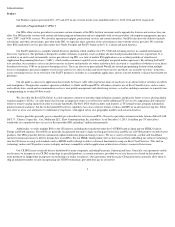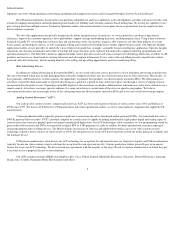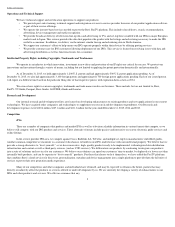TiVo 2015 Annual Report Download - page 18
Download and view the complete annual report
Please find page 18 of the 2015 TiVo annual report below. You can navigate through the pages in the report by either clicking on the pages listed below, or by using the keyword search tool below to find specific information within the annual report.
Table of Contents
Our strategic investments may involve joint development, joint marketing, or entry into new business ventures, or new technology licensing. Any
joint development efforts may not result in the successful introduction of any new products or services by us or a third party, and any joint marketing
efforts may not result in increased demand for our products or services. Further, any current or future strategic acquisitions and investments by us may not
allow us to enter and compete effectively in new markets or enhance our business in our existing markets and we may have to impair the carrying amount of
our investments.
Our success is heavily dependent on our proprietary technologies.
We believe that our future success will depend on our ability to continue to introduce proprietary solutions for digital content and technologies.
We rely on a combination of patent, trademark, copyright and trade secret laws, nondisclosure and other contractual provisions, and technical measures to
protect our IP rights. Our patents, trademarks and copyrights may be challenged and invalidated or circumvented. Our patents may not be of sufficient
scope or strength or be issued in all countries where products or services incorporating our technologies can be sold. We have filed applications to expand
our patent claims and for improvement patents to extend the current periods of patent coverage. However, expiration of some of our patents may harm our
business. If we are not successful in protecting our IP, our business would be harmed.
Others may develop technologies that are similar or superior to our technologies, duplicate our technologies or design around our patents.
Effective IP protection may be unavailable or limited in some foreign countries. Despite efforts to protect our proprietary rights, unauthorized parties may
attempt to copy or otherwise use aspects of processes and devices that we regard as proprietary. Policing unauthorized use of our proprietary information
is difficult, and the steps we have taken may not prevent misappropriation of our technologies. Such competitive threats could harm our business.
We may make patent assertions, or initiate patent infringement or patent interference actions or other litigation to protect our IP, which could be costly
and harm our business.
We are currently engaged in litigation, and litigation may be necessary in the future, to enforce our patents and other IP rights, to protect our trade
secrets or to determine the validity and scope of the proprietary rights of others.
We, and many of our current and potential competitors, dedicate substantial resources to protection and enforcement of IP rights. We believe that
companies will continue to take steps to protect their technologies, including, but not limited to, seeking patent protection. Companies in the technology
and content
-
related industries have frequently resorted to litigation regarding IP rights. Disputes regarding the ownership of technologies and their
associated rights are likely to arise in the future and we may be forced to litigate to determine the validity and scope of other parties' proprietary rights. Any
such litigation is inherently risky, the outcome is uncertain, could be costly, could distract our management from focusing on operating our business, could
delay recognition of revenue until a settlement or decision is ultimately reached, could result in the invalidation or adverse claims construction of patents,
and might ultimately be unsuccessful. The existence and/or outcome of such litigation could harm our business.
In 2014, the Supreme Court of the United States decided the Alice Corp v. CSL Bank International ("Alice") case. The Alice case generally
addresses patentable subject matter, and specifically an exception to patentable subject matter for "abstract ideas." In the Alice case, the court provides
some general interpretive guidance to be considered when determining whether patent claims are directed to patent
-
ineligible abstract ideas, along with a
two
-
step test for determining patentable subject matter eligibility going
-
forward. Practically, the effects of the Alice decision are still being assessed by
patent holders, attorneys, the United States Patent & Trademark Office and various courts, all of which are attempting to determine the appropriate analysis
and boundaries of the Alice decision on other patents. In any event, the Alice decision will provide potential licensees and accused infringers of certain
patents
-
including our patents
-
new arguments to challenge the validity of such patents, which could cause some delays or risk in pending or future patent
negotiations or litigation.
Additionally, the relationships with our customers, suppliers and technology collaborators may be disrupted or terminated as a result of patent
assertions that we may make against them, which could harm our business.
Finally, adverse legal rulings could result in the invalidation of our patents, the narrowing of the claims of our patents, or fostering of the
perception by licensees or potential licensees that a judicial finding of their infringement is unlikely. Such results or perceptions could decrease the
likelihood that licensees or potential licensees may be interested in licensing our patents, or could decrease the amounts of license fees that they are willing
to pay, which could harm our business.
16
























